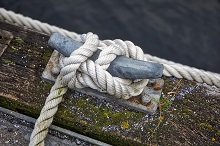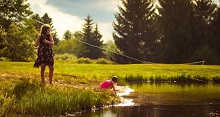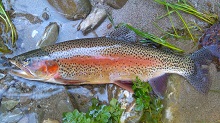
Plastic: Environmental Disaster
(Canadian Angling Jan. 7, 2014) We use plastic daily in our lives, but new research is showing that this can be a potential environmental disaster right on our doorstep. Recently scientists from the University of London England completed some research on the Thames River bed and found disturbing results. They found thousands of pieces of plastic on the river bed. Is this also happening in our rivers and oceans in North America, sadly, yes.
The scientists used nets designed for crabs and they measured and recorded their finding during a 3 month period. They found 8,000 pieces of plastic which included all types of packaging, cups and sanitary products.
“The unusual aspect of the study is that these nets are originally designed to trap fish and crabs moving along the river bed, so we can see that the majority of this litter is hidden below the surface. This underwater litter must be taken into account when predicting the amount of pollution entering our rivers and seas, not just those items that we can see at the surface and washed up on shore. The potential impacts this could have for wildlife are far reaching: not only are the species that live in and around the river affected, but also those in seas that rivers feed into” said Dr Dave Morritt, a Senior Lecturer in Marine Biology at Royal Holloway and co-author of the study.
The interesting thing to note is that the larger items, like plastic bags, were not recorded because they wouldn’t fit into the small nets, so the actual amount of plastic will be higher.
“All of this waste, which was mostly plastic, was hidden underwater so Londoners probably don’t realize that it’s there. Plastic can have a damaging impact on underwater life. Large pieces can trap animals but smaller pieces can be in advertently eaten. This litter moves up and down the river bed depending on tides. The movement causes the pieces of plastic to break down into smaller fragments. These are small enough to be eaten by even the smallest animals, which are in turn eaten by larger fish and birds. Once digested, plastic can release toxic chemicals which are then passed through the food chain. These toxic chemicals, in high doses, could harm the health of wildlife” Dr Paul Clark, a researcher, at the Natural History Museum and co-author of the study.
Now, what happens to all this plastic? Plastic is biodegradable by sunlight, water, bacteria, enzymes, and starch but what do they break down into? Since most plastics are made from petrochemicals…. And they also have additives, which can be toxic. A good example is plasticizers which are added to brittle plastic (Polyvinyl Chloride), to make them softer and pliable enough for food packaging, toys, etc. Some of this can leach out of the product.
Now, is the plastic getting into the food chain? Recent research at the Finnish Environment Institute has found that microplastics are transferred in the marine food web. Their study found that many plankton organisms are unable to separate plastic particles from their natural food.
Outi Setälä from the Finnish Environment Institute stated: “Although polystyrene microspheres were egested by planktonic crustaceans naturally, it is not yet known how plastics of different shapes and sizes found in the environment behave inside the organisms.”
The findings are from an EU-financed project during which researchers from the Finnish Environment Institute collected microlitter samples from the sea and monitored under laboratory conditions how small plastic particles travel in the planktonic food web.
They took a number of zooplankton taxa and exposed them to 10-micrometre (µm) fluorescent polystyrene microspheres and the zooplankton labelled with ingested microspheres, which included copepods and polychaete larvae. The plastic was eaten by the plankton and then the plankton was fed to larger crustaceans and they found that the crustaceans now had the fluorescent microspheres in theur systems. These microspheres had moved up the food chain. Will they eventually work up the food chain to humans? You know the answer…
Outi Setälä stated: “Microplastic particles can end up in the sea as a result of industrial discharges or with urban waste water, which can contain microplastics originating from day-to-day consumer goods. For example, some skin peel products and toothpastes include substances that contain tiny abrasive plastic particles. Some marine microplastics are the result of larger pieces of plastic that disintegrate in the sea.”
“If we do not intervene in the accumulation of microplastics in the sea, we could be contributing to a new kind of environmental issue. Since these plastic particles are the same size as the natural food of many marine organisms, it is possible for microplastics to accumulate in marine food webs through water and benthic communities,” Outi Setälä says.
Wayne Sheridan reporting for Canadian Angling.com



